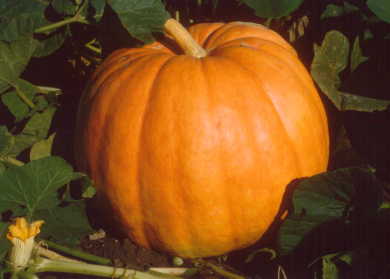(120 days) Open-pollinated. These are big pumpkins. Not big enough to compete in giant-pumpkin contests (you’d need Dill’s Atlantic Giant, not offered by us) but certainly sufficient for exhibiting in your county fair or for displaying as an awesome jack-o’-lantern. Typically weighs 50–100 lb and measures up to 70" in circumference! ④
Big Max Large Pumpkin
Big Max Large Pumpkin
(120 days) Open-pollinated. These are big pumpkins. Not big enough to compete in giant-pumpkin contests (you’d need Dill’s Atlantic Giant, not offered by us) but certainly sufficient for exhibiting in your county fair or for displaying as an awesome jack-o’-lantern. Typically weighs 50–100 lb and measures up to 70" in circumference! ④
Additional Information
Cucurbita maxima
Green in stems signifies immature fruit. Fat round stems turn corky and woody when the squash is ripe. Fruits tend to be medium to large and often have bumpy surfaces and button-ends.
Pumpkins
- 100–280 seeds/oz. ⅛ oz packet sows 3–8 hills.
- Days to maturity are from direct seeding.
Botanically, there are no such things as pumpkins. But we know one when we see one. “Pumpkins” listed here are three species; Cucurbita pepo (mini pumpkins, small pie and some jack-o’-lanterns), C. moschata (cheeses) and C. maxima (jack-o’-lanterns, decorative and culinary).
Culture: May be direct-seeded or transplanted. Direct seeding: Sow 4–5 seeds per hill when weather has warmed after danger of frost. Allow 4–6' between hills. Thin to 3 best plants. Use row covers and low tunnels to hasten maturity and reduce insect damage. Transplanting: Start indoors three weeks before setting out. Do not disturb the roots. Transplant bush varieties 18" apart, vining varieties 30" apart. Tender, not frost hardy. Heavy nitrogen feeders. Excessive heat and/or drought can prevent blossom set, reduce yields. Pumpkins can take one or two light frosts on the vine. To improve flavor and storage, field cure for at least 10 days after harvest, covering if hard frost threatens. Store under proper conditions, at least 50° and 60–70% relative humidity in a place with good air circulation. Do not pile up pumpkins. Inspect periodically and be sure to use damaged, stemless or small fruit first. Minimum germination temperature 60°, optimal temperature range 70–90°.
Saving Seed: Saving pumpkin seed is challenging! We list three species of the genus Cucurbita: C. pepo, C. maxima and C. moschata. Varieties of the same species will cross readily, but crossing will not occur between the different species. You must isolate varieties of the same species by half a mile if you want true-to-type seed. This is difficult for most gardeners—you may have to communicate and collaborate with neighboring gardeners, or exclude insects from blossoms and hand-pollinate. If you can pull off the variety isolation, processing the seeds is easy: rinse seeds from the guts of fully ripe and cured pumpkin. Dry and store.
Diseases: BR: Black Rot, PM: Powdery Mildew
Pest: Striped Cucumber Beetle
Cultural controls: use tolerant or resistant varieties, rotate crops, till under crop debris soon after harvest, use floating row covers until flowers appear, use plastic mulch, perimeter trap cropping (Black Zucchini and Blue Hubbard make particularly good trap crops), use yellow sticky strips, hand-pick early morning when beetles are very sluggish.
Materials: Surround, Pyrethrum (PyGanic).
Pest: Squash Bug
Cultural controls: rotation, till in cucurbit debris before winter and plant a cover crop, boards on soil surface near squash will attract bugs overnight which can be killed, avoid mulching. Squash bugs lay their brown-brick red egg clusters on the underside of the foliage, often next to the central vein—destroy egg clusters on undersides of leaves.
Materials: Pyrethrum on young nymphs, AzaMax.
Pest: Squash Vine Borer
Cultural controls: butternut squash is resistant, maximas & pepos susceptible; rotation, plow in squash vine debris soon after harvest, use floating row covers, watch for wilting plant parts and destroy borer within.
Disease: Powdery Mildew
Controls: Use small plots to slow spread, plant indeterminate (viney) varieties, control weed competition.
Materials: sulfur and whole milk, mineral or other oils in combination with potassium bicarbonate.
Disease: Bacterial Wilt
Cultural control: Striped Cucumber Beetle is vector—control it; choose resistant varieties.
Germination Testing
For the latest results of our germination tests, please see the germination page.
Our Seeds are Non-GMO

All of our seeds are non-GMO, and free of neonicotinoids and fungicides. Fedco is one of the original companies to sign the Safe Seed Pledge.


